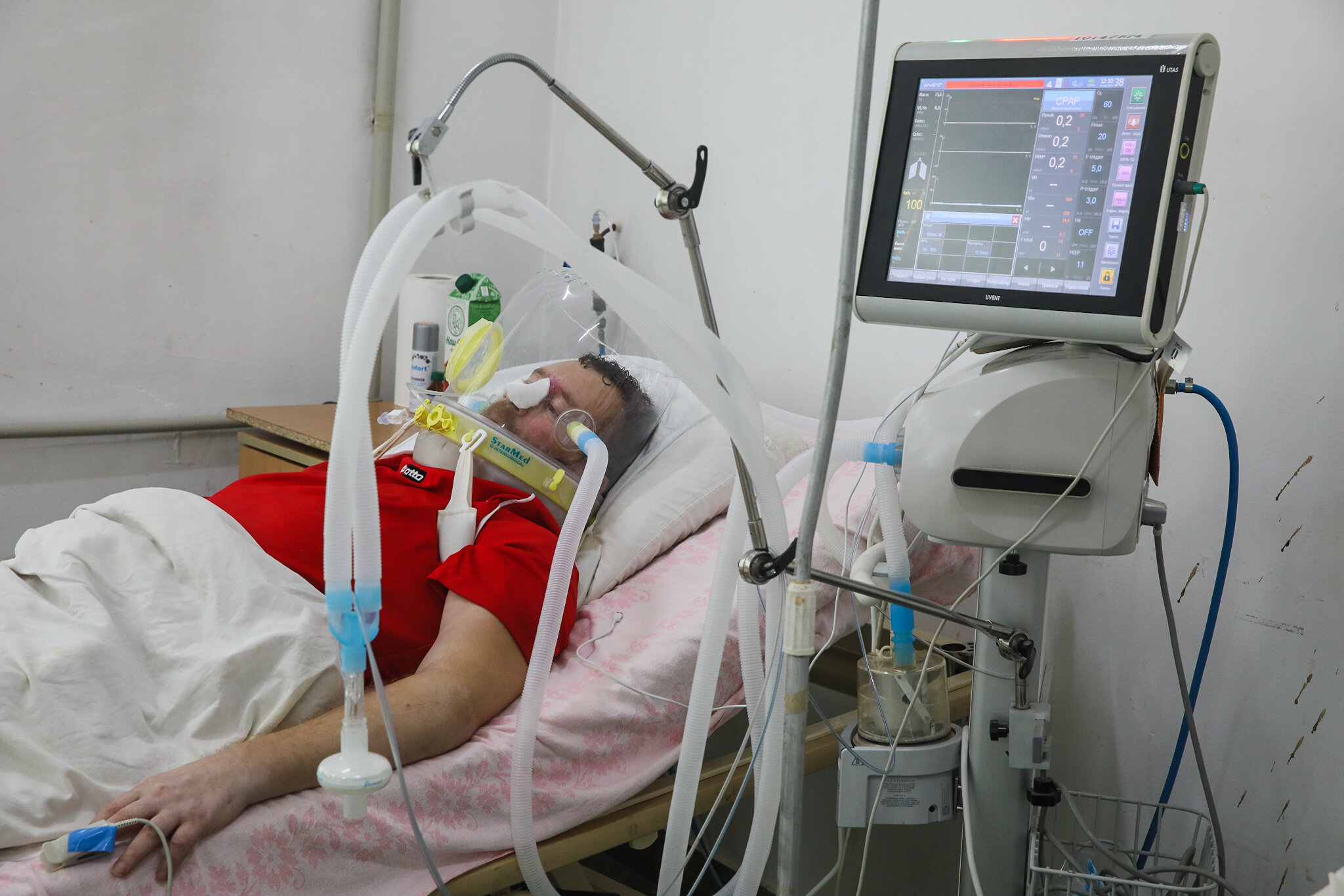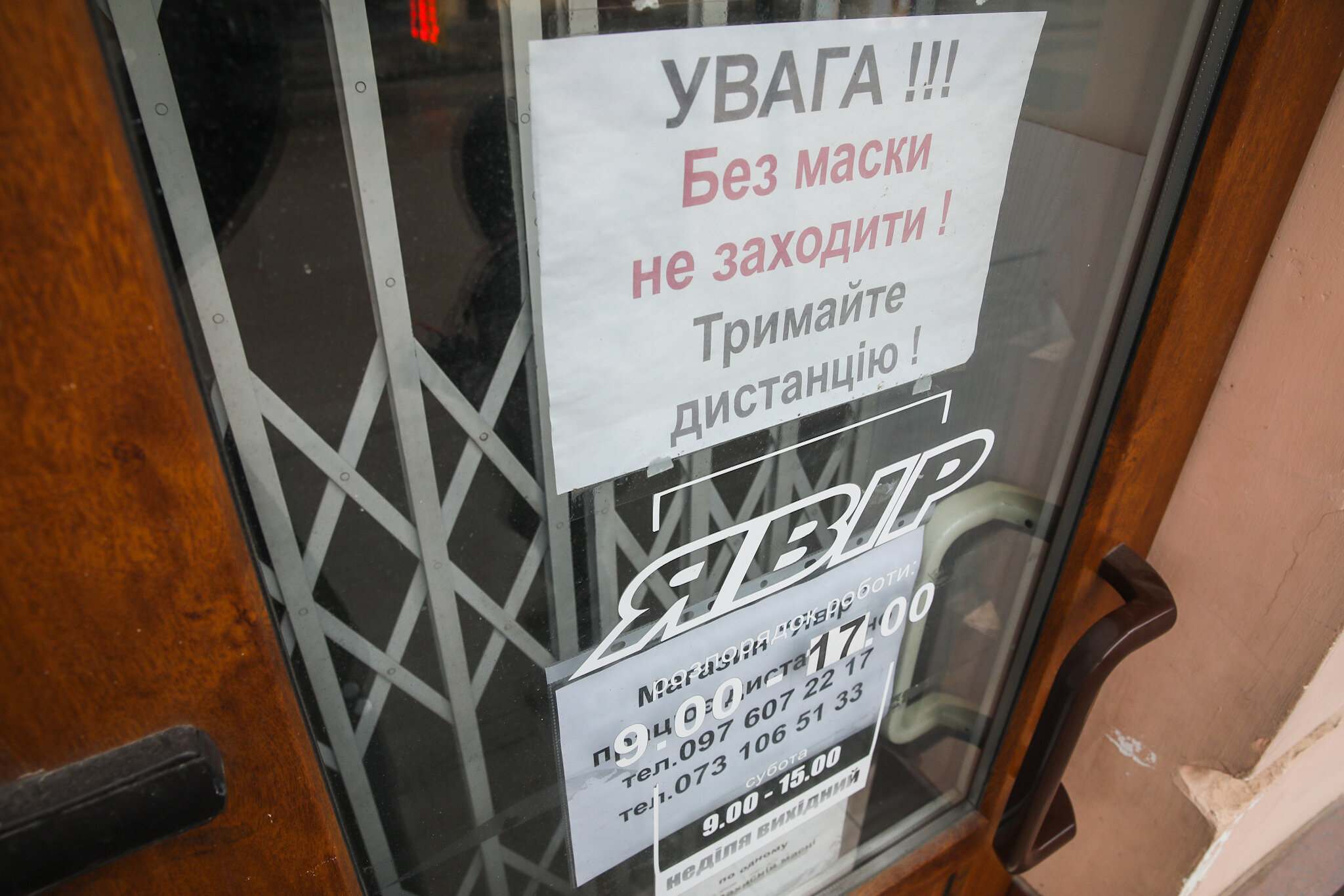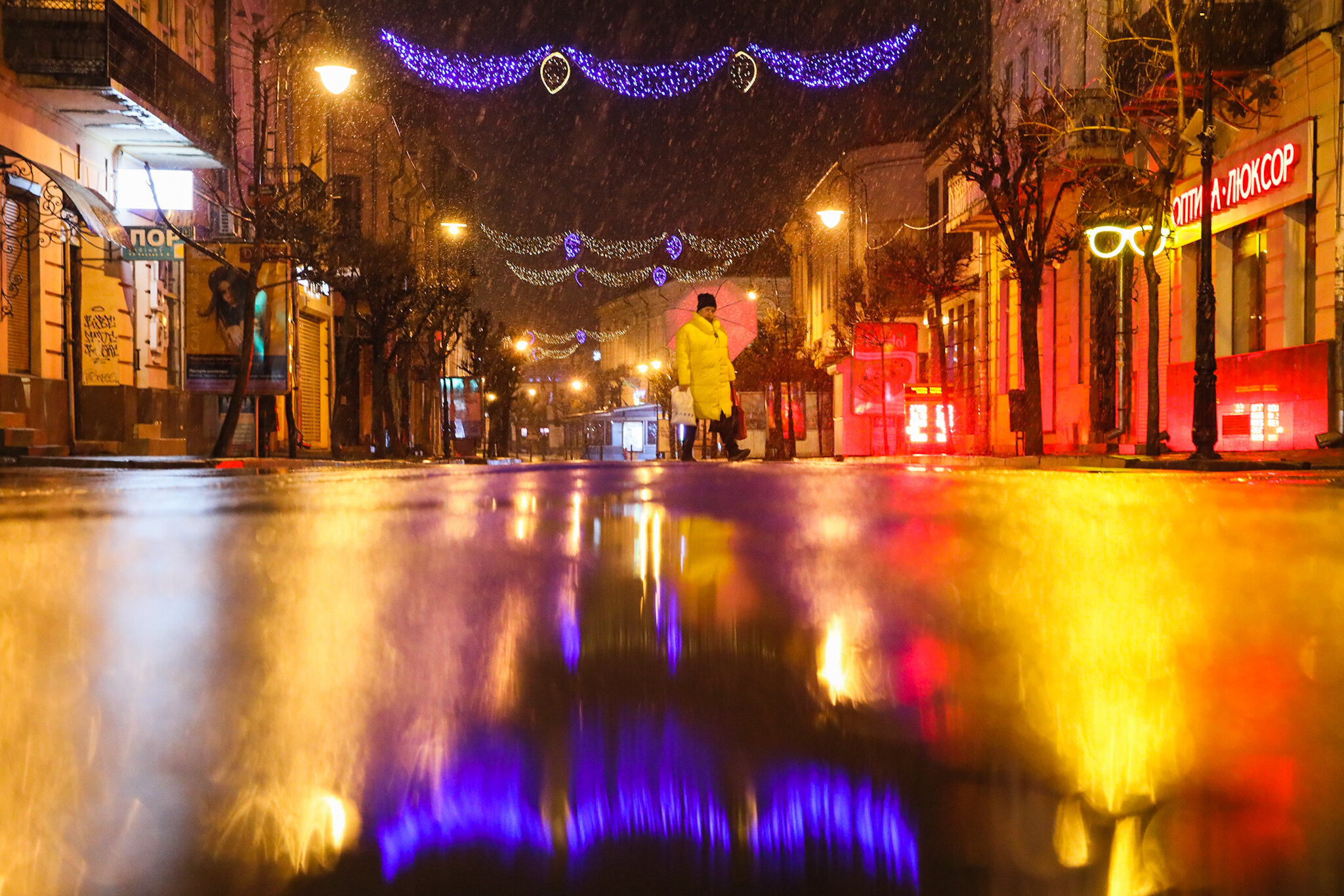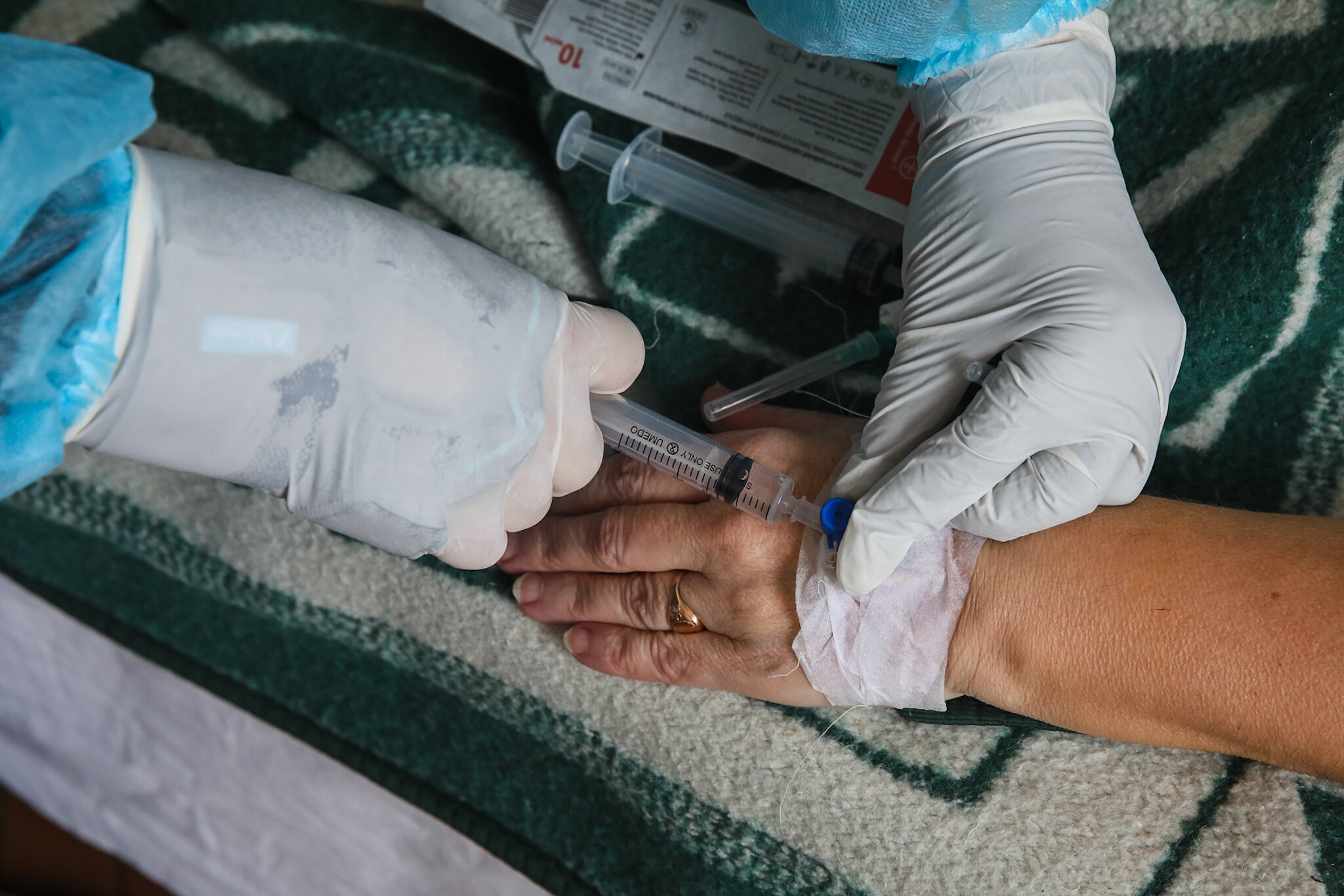It’s a tough morning for the patients of a four-bed intensive care ward in Kolomyia district hospital in western Ukraine.
Only three of them woke up this morning. The fourth, a 67-year-old man, died of coronavirus complications.
JOIN US ON TELEGRAM
Follow our coverage of the war on the @Kyivpost_official.
“He was half-blue. This means that a big blood clot broke and clogged a major blood vessel,” says medical director Viktor Boyko, pointing at the body in the black bag, still on the hospital bed.
- Obtain the most current Ukraine news articles released today.
“The worst thing for a doctor is the eyes of the patients he lost,” he says, “You see them in the night when you dream. These eyes are begging for help, full of despair and fear. With each dying patient, the doctor who treated and lost him, dies for a minute, too.”
A thin striped curtain separates the dead from the living.
On the one side of it, there is the black body bag.
On the other, 57-year-old Vasyl Stefurak looks forward to being discharged. “First thing I will do when I get out is go fishing,” he says as he lies on his stomach, wearing an oxygen mask.
Although Stefurak and the other patients in the ward don’t see the black body bag with their neighbor, they know that he died and this scares some of them.
On the opposite side of the ward, a woman in her 30s starts breathing heavily.
“She’s young but she started feeling worse,” Boyko says. “We are looking into whether her indicators dropped after she saw what happened.”
Ihor Klapko, head of the hospital’s inpatient department, puts it this way: “These days, all of the patients fear death.”
Since the beginning of the pandemic, 205 patients have died of coronavirus in this hospital.
According to the administration, COVID‑19 has almost doubled the institution’s annual mortality rate.
“Someone is dying almost every day,” Klapko says.
The hospital is in the Ivano-Frankivsk Oblast, more than 500 kilometers west of Kyiv. It is at the heart of the region that is hit especially hard with COVID‑19.
As of March 18, four oblasts in western Ukraine, as well as the cities of Kyiv and Lviv, are in the “red zone” by the government’s classification. They had to introduce lockdowns due to the rising number of infections and, most importantly, a shortage of hospital beds.
The government calls it the third wave, and scientists predict it to be the deadliest yet.
The Kolomyia hospital is at the front line of this crisis.
Strong thirst for life
In another intensive care ward, there are two 46-year-old men. Despite their relatively young age, they are among the most critical patients in the hospital. They’re also the most determined to survive.
“Patients with a strong thirst for life. This is what we call those who do not give up, who are strong-spirited and follow our recommendations, often forcing themselves to do so,” says anesthesiologist Vitaliy Yakubiyak.
“Taras and Vasyl are vivid examples of the fact that not everything depends on the nurse, the doctor, the medicine. The patient also contributes to their treatment process. The patient must work for it.”
Vasyl has been in intensive care for three months. He has worn an oxygen mask for so long that his nose has started to rot. To save his face, the doctors had to switch him to an oxygen helmet.
“Here is a hole — he eats through it; he drinks through it. If you take the valve off, the helmet becomes soft. It is airtight, see,” Yakubiyak shows how the helmet works.
With the valve open, Vasyl starts coughing. He looks at the doctor, terrified.
“Do not be afraid,” Yakubiyak says and closes the valve. “Do not be afraid.”
Vasyl is fully dependent on the beeping machine next to his bed that provides him with air. Without it, he would survive for only a few minutes. While his spirit is strong, the disease and the long hospital stay weakened his body. Doctors help him stand up and sit back down to get some exercise.
“He still lacks muscle strength. But we will overcome it. Right, Vasyl?” the doctor asks.
“We will,” Vasyl says.
“We will exercise and get him home by Easter,” Yakubiyak says, meaning early May.
Vasyl’s neighbor, businessman Taras Biyovsky, is breathing through an oxygen mask. He regrets he did not take the coronavirus seriously enough.
“You do not understand it until you wake up in the middle of the night and feel a catastrophic lack of oxygen, you want to breathe and you can’t,” Biyovsky sighs.
“At that moment, you realize how serious this disease is, how you’re balancing between life and maybe something else we do not fully understand yet. This is a warning to everyone else not to neglect their safety,” says the father of five. A mug labeled “Best Dad” sits on his bedside table.
Many people here used to think like Biyovsky did before he contracted the virus, ignoring quarantine restrictions, doctors say. Boyko says that the outbreak wouldn’t be so bad if Ukrainians didn’t have such a strong urge to go to resorts and celebrate.
“And when they say: ‘I am going on holiday because I am healthy.’ You only think you are healthy. There is a saying among doctors: ‘There are no healthy people, only poorly examined ones,’” he says.
Struggling hospitals
Ivano-Frankivsk Oblast, where the hospital is located, became a “red zone” on Feb. 26. A special commission recognized that the COVID‑19 situation in the region was critical and raised quarantine measures to their highest level. Officials set up checkpoints to restrict access to the area, canceled public transport, and closed shopping malls, restaurants and markets.
But by then, local hospitals were overflowing with patients. In late February, Kolomyia district hospital, which has a capacity of 175 beds for coronavirus patients, had to use additional beds to fit 191 people.
Things are a little better now. The Kolomyia hospital’s coronavirus unit is back down to 170 patients. This is not because the outbreak is letting up but because three nearby hospitals started admitting patients with COVID‑19.
One of them is Bohorodchanska hospital. It is tiny, able to fit only 30 patients with coronavirus. In late February, a 120-bed mobile hospital was set next to it.
But even after mass infections began, not everyone followed quarantine restrictions. The local market is open despite the ban. Some shops pretend to be closed but still let in customers.
“Many people did not believe in the coronavirus here. But now so many have contracted it, some started speaking up about it,” says Liubov Rymaruk, a resident of Kolomyia. “People used to hide it from everyone because they were afraid of what the neighbors would say.”
Ukraine’s third wave of coronavirus is gaining momentum. Four oblasts have been designated “red” zones including Ivano-Frankivsk, Uzhhorod and Chernivtsi in western Ukraine and Zhytomyr in northern Ukraine. Most of the rest are “orange” and aren’t far from tipping into the red.
“The outbreak in Ukraine started here,” Klapko says, referring to the March surge of infection hitting western Ukraine. “And this is what will happen next — it will spread throughout central, eastern, and southern Ukraine, I’m afraid.”
“Colleagues in the rest of the country must expect it and be prepared,” he adds.
‘The war is here’
Even though the war with Kremlin-financed separatists is in the Donbas, 1,200 kilometers away from Ivano-Frankivsk Oblast, doctors here feel like they are on the front line too.
“Trust me, the war is here. Ukraine is fighting on two fronts now. One is with a visible enemy, which attacks in the east, and the other is a fight with an enemy that attacks from everywhere,” says Boyko, who served as volunteer military doctor in Donbas.
“This enemy is way more dangerous and insidious,” he says, “It is unpredictable and every medical worker is a fighter.”
The medical staff is worn out, often working without days off, doctors and nurses tell the Kyiv Post. They don’t complain. Overworking is something one can get used to, they say. The most difficult challenge is treating a colleague or relative.
Up to five medical workers are treated for coronavirus here at any one time. Two doctors are being treated in the unit at the moment.
Boyko walks over to check on his colleague Tetiana. Her condition has recently deteriorated.
“She is a general practitioner but the disease does not pick people on the basis of how much they know about it,” Boyko says, “The virus attacks everyone.”
“This doctor spent over 30 years of her life working for our institution. Now she works in a private clinic. She is an excellent professional,” Boyko says of his colleague. Almost the entire medical team of his has already had COVID‑19, including Boyko.
Svitlana Burchenko, a nurse, says the most difficult thing for her is to treat a relative.
“You are worried about your patients, but when your family members get to the hospital you worry even more,” she says. Burchenko’s uncle and child were treated for coronavirus in this hospital.
“I hear this every day from my colleagues: ‘It is difficult for us, it is psychologically difficult,” Boyko says.
There are 96 medical workers for the 175 COVID patients in the hospital. The administration says that’s not enough. Volunteers come to help out the doctors.
A priest began the volunteer movement in the Kolomyia hospital in August 2020.
“He was our first volunteer and we were pleasantly surprised when the priest came to take care of his parishioners,” Boyko says, “He took care of nearly ten patients. Some probably became his parishioners after they recovered.”
Being a volunteer is hard work, Boyko says. It requires taking care of not only your relative, but other patients, too.
“They wash the bedridden patients, they change the bedsheets, they change the portable toilets,” he says.
Vasyl Fedyuk is one of the volunteers. A veteran soldier and ambulance paramedic, he has been volunteering in the hospital for a month, taking care of his mother and father-in-law among other patients.
For Fedyuk, the front line is also here and it’s a harder battle than conventional war.
“I fought there. There were shooting, deaths, but you knew your family was safe. And psychologically it was easier,” he says, “And here you try to protect your relatives and you see that sometimes you cannot.”
Fedyuk’s father-in-law died in this hospital two days ago.
Oxygen
On March 13, the hospital used over 5.6 tons of oxygen. This would have been enough to last a year before COVID-19, the administration says. These days they normally go through 2-3 tons each day.
The oxygen comes from Karpat Naftochim, a chemicals producer based in Kalush, 100 kilometers north of Kolomyia.
“The peoples’ lives directly depend on oxygen. Without oxygen, some patients will not be able to survive for even five minutes,” says Klapko.
In February, the vehicle carrying liquid oxygen got stuck in a blizzard and was unable to deliver the cargo on time. The doctors came to the rescue.
“Me and Rostislavovych (Igor Klapko) were loading 43 reserve cylinders with oxygen ourselves. It was 2 a.m. on a Sunday. And Viktor Ivanovych (Boyko) was with us,” says Volodymyr Rakochuk, a locksmith.
“They cut off my finger!” interrupts Boyko, laughing.
They smile as they recount the story. But at the time, it was no laughing matter. It was a tough night full of terror for the patients’ lives.
“Six patients in critical condition on ventilators were about to die that night. This was my shift,” says anesthesiologist Volodymyr Dmytryk.
“If we experience an interruption in oxygen supplies, lives are at risk,” Klapko adds.
They dream about an oxygen generating station like some other hospitals have.
“The coronavirus made people realize what a breath of fresh air really means — something we don’t appreciate,” says Boyko.
Shot of hope
Hope is the fuel that keeps the hospital and its workers running.
“The light at the end of the tunnel — this is the only motivation I have so far, unfortunately,” says Klapko, “(I hope) that at some point it will get easier and this COVID‑19 will go away.”
Vaccines could bring the world closer to this goal.
Klapko, Boyko, and other doctors and nurses have already been vaccinated against COVID‑19. The vaccine arrived in the city on March 11.
However, Ukraine has only started its vaccination drive in late February and has just 500,000 doses, not nearly enough to cover even the highest priority group — medical workers and troops.
Meanwhile, new patients keep arriving. Kateryna Shepetyuk, a 71-year-old history teacher is waiting to be admitted at the reception desk.
“Computed tomography showed 50% lung damage and I was told that it is better to get hospitalized,” Shepetyuk says. “I hope everything will be okay, that they will help. They help many people. I hope they will help me too.”
While Shepetyuk is being admitted, a couple of pensioners are discharged.
“They cured everything perfectly. Well done,” a man says.
“I am so happy when people recover and go home like this man and this woman,” nurse Burchenko says. “I look at their faces and am so pleased that they go home.”
You can also highlight the text and press Ctrl + Enter










































